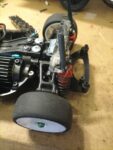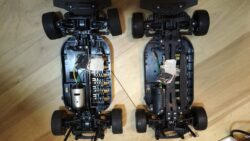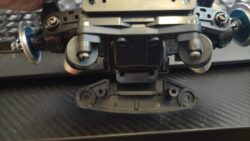Menu
- Articles
- About Us
- Member Login
- Books on modern Tamiyas
- Books on legacy Tamiyas
- Book on RC cars (non Tamiya specific)
- Other RC books
- Books on RC Flying
- Books on RC 3D Printing / CNC
- Order our books
- FREE Resources
- Reviews
- Tech Tips
- RC Videos
- 3D Print
- InfoAPP
- InfoAPPs on RC Cars – Suspension System related
- InfoAPPs on RC electronics – Batteries
- Find the minimum cutoff voltage of a RC lipo pack
- Find the proper storage voltage of a Lipo pack
- Find the fully charged voltage of a RC lipo pack
- Find the proper cell count for your RC Plane
- Find out how many Amps your RC car lipo pack can push
- Find out how much battery power you need given a particular prop size
- InfoAPPs on RC cars – Drive Train
- InfoAPPs on RC electronics – Radio
- InfoAPPs on RC electronics – Motor & ESC
Category Archives: Tech Tip – Chassis
TT01 rear gear diff case breakage

The Tamiya TT-01 rear gearbox loose problem is a common issue among the TT-01 chassis. This is when the rear gearbox housing aka differential case becomes loose, which can result in drivetrain instability, gear misalignment, or even stripped gears over time. The screws securing the gearbox halves may loosen over… Continue reading
Tamiya BT01 front bumper
Kyosho Fazer Mk2 Vs Tamiya TT02

Out of the box the Fazer mk2 has a 32t pinion 48dp, so if the same motor and battery are deployed then the TT02 will be slower…. TT02 has a 22t pinion driving a 70t spur… And physically you cannot put in large pinion due to space limitation… The video… Continue reading
MTS FFV4 “Dolphin” FWD
TD4 front suspension
Tamiya Wild One issues
The front bottom gearbox cover of the Manta Ray
Localized stress around screw holes

Damage around screw holes seems a common issue on Tamiya cars. It could have occurred due to a combination of factors. Screw holes create points of stress concentration in the chassis. When a screw is tightened, the material around the hole experiences higher stress than other areas of the chassis…. Continue reading
Tamiya DF01 motor heatsink issue

An RC car motor generates heat as it operates, and if the heat is not dissipated effectively, it can cause the motor to overheat and potentially fail. A heatsink is designed to absorb and dissipate the heat generated by the motor, keeping it at a safe operating temperature and improving… Continue reading








